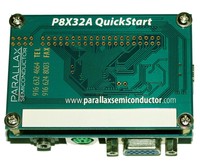Propellerpowered Pocket Mini Computer
| Home > Browse Our Collection > Computers > Parallax > Propellerpowered Pocket Mini Computer |
|
This Propellerpowered Pocket Mini Computer consists of a Parallax P8X32A Quickstart Board, VGAplus board, and a universal MicroSD adapter, and was available to buy as a kit. The P8X32A Propeller QuickStart is a simple and accessible development platform for the P8X32A Propeller microcontroller. The Pocket Mini Computer features:
Very kindly donated by Alexander Demin. A further explanation of the kit can be found at Alexander Demin's webpage: https://demin.ws/blog/english/2012/11/22/personal-mini-computer-on-parallax-propeller/ Manufacturer: Propellerpowered, Parallax Comment on This Page This exhibit has a reference ID of CH32378. Please quote this reference ID in any communication with the Centre for Computing History. |
|












